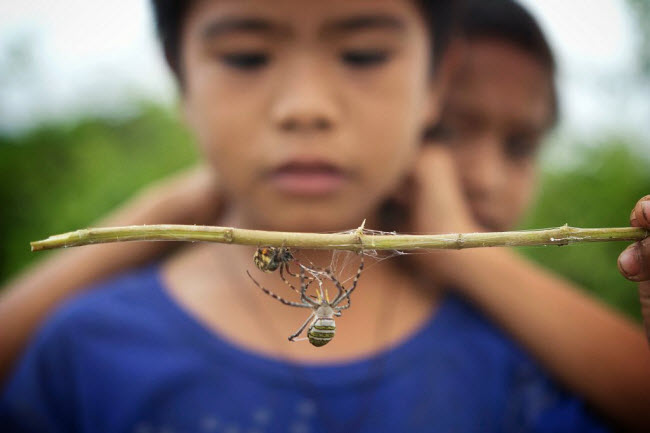A ring unlike any other, where two competitors face off, surrounded by a crowd eager to see their favorite fighter emerge victorious. As the match begins, the fighters engage in a fierce battle, with the audience cheering them on until one competitor overwhelms the other. You might think this is a typical wrestling match, but that’s only partially true. The fighters in this arena are not humans; they are spiders, battling it out in a sport known as spider fighting. This unusual sport is popular in several Asian countries, with annual professional tournaments sponsored by betting agencies. The rules of spider fighting vary by country, including preferences for male or female spiders and specific species chosen for the matches. The nature of the fight may also differ, with some bouts ending in death while others conclude when one spider flees.
Spider Fighting in the Philippines
In the Philippines, spider fighting is a popular pastime among rural children, particularly in the Visayas region. The game begins by placing two spiders on opposite ends of a stick, encouraging them to move toward each other until they clash. These spiders are usually adult females of the Neoscona species, known for their web-spinning abilities. They are often caught early in the morning or at dusk when they are most active in spinning webs. The captured spiders are stored in matchboxes, which are divided into compartments to house multiple spiders, typically made from cardboard or folded coconut leaves.

The match takes place on a bamboo stick, with spiders placed at either end and encouraged to move toward each other to fight. The stick is thin enough to ensure the spiders have no choice but to face off. A child holds the stick to prevent the spiders from escaping to another location. The fight ends according to pre-agreed terms, either in a lethal outcome where one spider kills the other by biting, paralyzing, or quickly wrapping it in silk, or in a non-lethal outcome where the match concludes after one spider falls off the stick once or multiple times. In non-lethal bouts, the child holding the stick may need to intervene quickly to prevent the winning spider from killing the losing one.
In addition to amateur matches, there are formal competitions known as “Kaka Derby,” held in arenas where two poles are connected by a narrow string with a polystyrene foam cushion underneath to prevent injuries to the spiders if they fall. These matches involve significant gambling, with the best fighters fetching up to 100 pesos (around 2 USD). Despite its popularity, spider fighting is controversial, as it is believed to negatively impact children’s education, with many students spending more time catching and training spiders than on their studies. Adults also participate in this sport, akin to cockfighting, with derbies where bets can reach up to 50,000 pesos (approximately 1,000 USD). Due to the ease and low cost of keeping fighting spiders compared to roosters, some enthusiasts have shifted from breeding fighting cocks to raising spiders.
Currently, there are laws in the Philippines targeting this sport in some areas. In Negros Occidental, spider fighting is treated as a threat to public morals, and the Bacolod police chief issued a warning against participating in any form of illegal gambling associated with it. While spider fighting as a hobby is not illegal, it becomes so once bets are placed on the matches.
Spider Fighting in Japan
Spider fighting is an annual event in the Japanese city of Kajiki, where the competition is known as “Kumo Gassen.” The spiders used in these matches belong to the Argiope species, which are large and are often allowed to roam freely in their owners’ homes. This sport is said to have been practiced since the 16th century and is conducted in a manner similar to the Philippine version. One spider, known as “Kamai,” is placed on one end of the stick, and the other spider, called “Shikake,” is placed on the opposite end. The two spiders meet in the middle to fight, with judges closely observing the fast-paced battles to determine the winner based on which spider bites first, which one wraps the other in silk, or when one spider knocks the other off the string. The judges may use their hands to separate overly aggressive spiders or to encourage reluctant fighters to resume the match. The competition follows a tournament format, culminating in a final match between the last two spiders standing.

Spider Fighting in Singapore and Malaysia
In Singapore and Malaysia, the spiders used in spider fighting belong to the Thiania bhamoensis species, known for their jumping abilities. Capturing and caring for these spiders is a popular activity among young people in both countries. During the 1960s and 1970s, this practice had a significant financial impact on some participants due to the bets placed on the matches.
Spider Fighting in the United States
Spider fighting is not limited to Asia; it has also found its way to the United States, particularly in Florida prisons. Here, inmates catch and keep spiders as pets in boxes. In 2002, a fight over the theft of a pet spider among three inmates led to severe injuries and additional charges for two of them.
